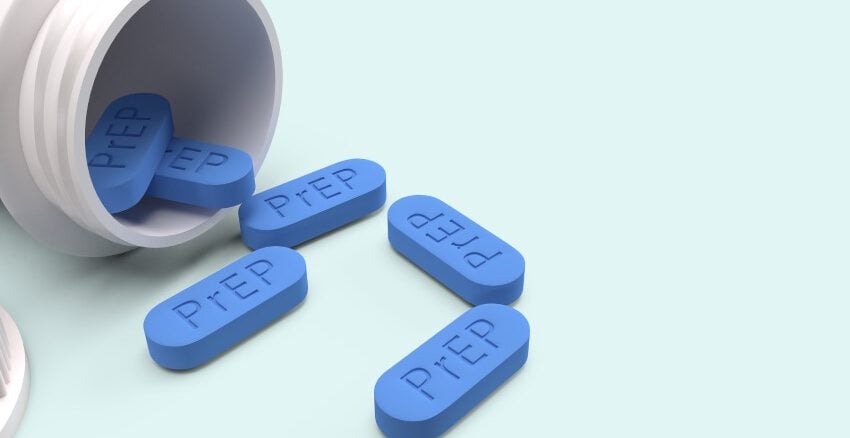
What Is PrEP?
PrEP stands for Pre-Exposure Prophylaxis. It’s a daily or event-based medication regimen that, when taken as prescribed, reduces the risk of HIV infection by up to 99% through sexual contact and at least 74% for people who inject drugs.
There are two main types of PrEP approved in the U.S.:
-
Oral PrEP (pills): e.g., Truvada® and Descovy®.
-
Long-acting injectable PrEP: e.g., Apretude® (cabotegravir), given every two months.
Key point: PrEP does not prevent other sexually transmitted infections (STIs) or pregnancy, so barrier protection and regular checkups remain important.
How Does PrEP Work?
HIV needs to replicate inside your body to establish infection. PrEP blocks the virus at the earliest stage, preventing it from establishing itself. For maximum protection:
-
Start taking PrEP at least 7 days before vaginal sex or 21 days before receptive anal sex (oral regimens).
-
Injectable PrEP reaches protective levels within days of the first shot.
Adherence matters. Missing doses decreases protection.
Who Should Consider PrEP?
PrEP is recommended for individuals at higher risk of HIV, including:
-
People with HIV-positive partners whose viral load is not suppressed.
-
Those with multiple sexual partners or inconsistent condom use.
-
People who inject drugs and share needles or equipment.
-
Anyone who’s had an STI in the last 6 months.
PrEP is not limited to one group. It’s for anyone who wants peace of mind and control over their sexual health.
Benefits Beyond Protection
-
Peace of mind: Reduced anxiety about HIV risk.
-
Health empowerment: Regular checkups and STI screenings mean better overall sexual health.
-
Community impact: When more people use PrEP, community HIV rates decline.
For healthcare professionals, expanding PrEP services can also create income opportunities. Clinics, telehealth providers, and pharmacists offering PrEP consultations or prescription refills may see increased patient volume, which can diversify revenue streams while serving a vital public health function.
How to Access PrEP: Steps to Get Started
-
Talk to a Healthcare Provider
Schedule an appointment with a primary care doctor, sexual health clinic, or telehealth provider. They’ll assess your risk, perform an HIV test, and check your kidney function before prescribing PrEP. -
Choose the Best Option for You
Oral pills or long-acting injections? Discuss your lifestyle, adherence ability, and insurance coverage. -
Regular Monitoring
Once on PrEP, you’ll need HIV tests every 3 months (for pills) or at each injection visit. This ensures continued safety and effectiveness. -
Insurance and Cost Assistance
Many insurance plans, including Medicaid, cover PrEP at little or no cost. The U.S. Department of Health and Human Services also runs the “Ready, Set, PrEP” program, providing free medication to eligible uninsured individuals.For clinics and healthcare providers, offering assistance with insurance navigation or enrolling patients in support programs can build trust and generate service fees.
Affording PrEP: Practical Tips
-
Check your insurance policy: Under the Affordable Care Act, most plans must cover PrEP without cost-sharing.
-
Use patient assistance programs (PAPs): Gilead and ViiV offer co-pay cards or free medication to eligible patients.
-
Seek community health centers: Many offer PrEP at low or no cost, along with counseling and lab tests.
-
Telehealth services: Online PrEP providers can ship medication discreetly and may offer subscription-based models that lower monthly costs.
For professionals, becoming an authorized PrEP navigator or establishing a telehealth service can be a viable way to earn income by helping patients access these benefits.
Common Myths About PrEP Debunked
Myth 1: PrEP is only for gay men.
Reality: PrEP is for anyone at risk, regardless of gender, sexual orientation, or identity.
Myth 2: Taking PrEP encourages risky behavior.
Reality: Studies show most people continue to practice safer sex while on PrEP, and some even improve their health-seeking behaviors.
Myth 3: PrEP causes severe side effects.
Reality: Most side effects are mild and temporary (headaches, nausea). Serious side effects are rare and monitored by your provider.
Integrating PrEP into a Holistic Prevention Plan
While PrEP is highly effective, combining it with other strategies maximizes protection:
-
Condom use for protection against other STIs.
-
Routine testing for HIV and STIs.
-
Vaccinations such as hepatitis B and HPV.
-
Risk-reduction counseling and support groups.
Professionals providing PrEP services can differentiate themselves by offering holistic sexual health packages, increasing both impact and income.
Opportunities for Healthcare Professionals: Building Income Through PrEP Services
If you’re a nurse, pharmacist, or clinician, the growing demand for PrEP creates avenues to:
-
Offer PrEP consultations in your clinic or pharmacy.
-
Develop telehealth platforms for remote prescribing and follow-up.
-
Host educational webinars or community outreach programs to attract new clients.
These initiatives not only support public health but also create additional revenue streams, positioning you or your organization as a trusted authority in HIV prevention.
How to Talk to Your Partner About PrEP
Starting PrEP can be a personal decision, but open communication strengthens relationships:
-
Explain that PrEP is about protecting yourself and your partner.
-
Share credible resources.
-
Encourage testing together and discuss other preventive measures.
Resources and Support
-
CDC PrEP Information: cdc.gov/hiv/basics/prep
-
Ready, Set, PrEP Program: getyourprep.com
-
Local Health Departments: Many offer free or low-cost PrEP clinics.
Professionals can partner with these programs to streamline referrals and grow their patient base.
Conclusion
PrEP is more than a pill or injection—it’s a revolution in HIV prevention. By understanding how it works, who it’s for, and how to access it affordably, you can take control of your health or help others do the same. For healthcare providers, the expanding PrEP landscape offers meaningful ways to increase income while making a lasting impact on public health.
Whether you’re considering PrEP for yourself or thinking about offering PrEP services professionally, now is the time to act. Knowledge, preparation, and proactive care are your best allies in staying HIV-protected.
